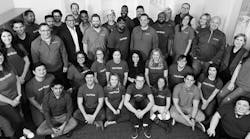Mark Victor Hansen said it best. “If you do things the same way you’ve always done them, you’ll get the same outcomes you’ve always gotten. In order to change your outcomes, you’ve got to do things differently.”
And this is exactly applicable to how we fund education in the U.S. and the resulting shortage of skilled workers.
“Through no fault of their own, employers are having trouble finding skilled workers, and this is because we have set up a system where after high school you must go to college to get a degree to get a job. And in this process, we created a system that has limited access to education for many people,"’ explains Chris Keaveney, CEO of Meritize.
Underpinning this system is how we finance it. If someone can qualify for a university education, there is federal funding available. But if someone wanted to pay for welding school, which costs an average of $19,000 for a two-year degree, there is no mechanism to fund that.
A New Funding Alternative
That’s where Meritize enters the picture. The company was founded by Chris Keaveney and Philip Stegner who between them have decades of credit and finance experience with large banks as well as leading marketplace lenders. They saw a gap in the financial system that was preventing access to funding that could be used to train people for skilled labor jobs.
The name of the company comes from using a merit-based model which can include a person’s academic or military achievements or work history in order to view creditworthiness from a different perspective. Almost 25% of Mertize borrowers would likely not have been approved by a traditional private student lender, said Keaveney.
"We need to view someone who wants to get an education as an investment, so you want to know that this person has demonstrated that they have the ability to be successful. This is especially true if you look at their job history and see how they have progressed at their current job, which tells us they are going to be successful if they are going to train for example, as a welder.”
Offering potential employees access to education funding and then matching them with skills training programs for jobs needed in fields such as manufacturing, is the ultimate goal of the company.
“We help students achieve their dreams, by helping them find training opportunities that we have vetted,” explains Keaveney. The company works with education institutions as well as employers. With employers, they will create customized talent solutions to meet the demand for workers in welding, wind turbine mechanics, HVAC, and aviation.
Employers Need to Be Talent Creators
Employers, too, need to view talent differently, says Keaveney. “They need to become talent creators, rather than talent consumers,” he says.
"They can continue to do what they essentially do today, which is be a talent consumer where they're spending thousands of dollars in trying to recruit talent, or they can become a talent creator, by working with someone like us where we create a pipeline of people who are getting the skills they need to fill the open jobs.
“Whether it's welders or diesel mechanics there are companies who are desperate to find folks who can fill these jobs and they are waking up to the fact that they need to be part of the process for creating this talent."
A Different Education System
One of the difficulties of adopting a new education is realizing that information might have been missing. “Many students aren’t informed about the alternative to college, especially about the pathways that can lead to high-paying skills-based jobs that can lead to good careers,” explains Keaveney. “But I do see the pendulum swinging toward that perspective and more high schools are adding these programs back in. However, this awareness needs to start earlier, at the middle school age where already kids are being placed on the four-year college track. What’s placed in front of them, that’s what they’ll do.”
And on the educator side, joining with Mertize, allows them to offer students access to funding opportunities that haven’t existed before. The company can fund disbursement to the school, offer flexible repayment options to the students, or act as borrower services for the students.
Mertize has relationships with about 450 schools and training programs that offer 2500 programs, and manufacturing is a key vertical says, Keaveney. His company works with students who want to enroll in these programs. Once halfway through their training, they are introduced to an employer partner. If hired, the company can contribute to the cost of the employees’ education.
A Successful Model
If the graduation rate is a metric that measures success, then this approach has been successful. The national six-year graduation rate at public institutions is around 60%. Potential partner schools that must pass Mertize’s school underwriting process to be accepted onto the platform have an expected graduation rate of 80-85%. For students who’ve attended Meritize platform schools, there is a 90% completion rate – a roughly 50% improvement over the national average.
“I believe the reason this has worked is that those receiving funding for these schools has already proven to have some trait or skill that determines their success rate,” says Keaveney. “Our program is there to fill in the gap between potential candidates who might not have access to funding the training they require, and companies who need these skills.




